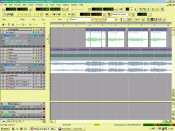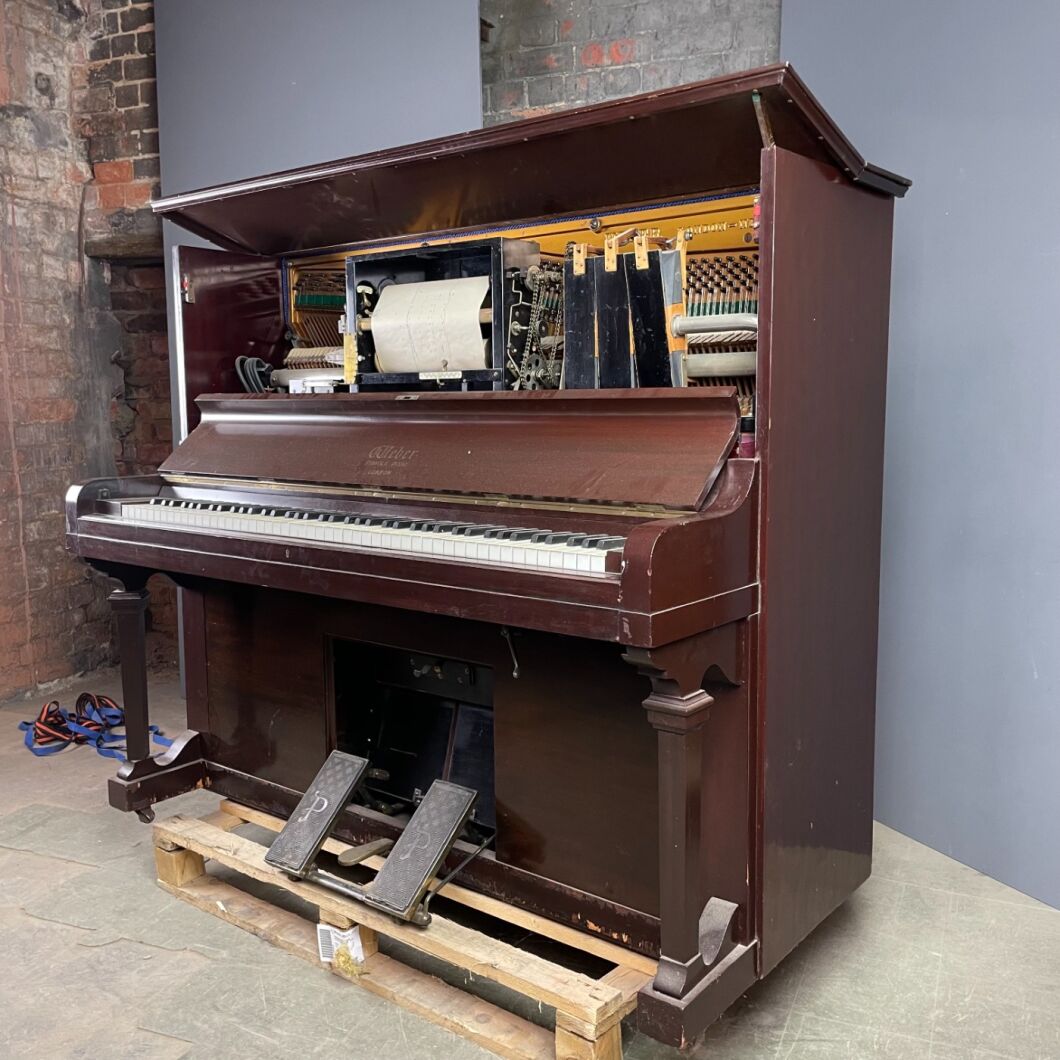




 ORCHESTRATION
ORCHESTRATION
For thoughts on how to orchestrate, try principles
of orchestration or artistic
orchestration.
For now I'll simply say very briefly that it usually goes something
like this:
- Pick a key (it doesn't matter which one, though start with majors)
- Write down which notes you're allowed and which the typical
chords are that are normally used in that key (I have posted all this
on this site)
- Write about 8 bars of chord sequence, starting with the same
chord as the key (e.g. C for C major).
- Either add audio loops (which should automatically adjust to the
chords) or orchestrate directly using the notes from the chord you
picked for that particular bar
- When you have either the whole backing or a section of it, add a
vocal guide.
Back in the day, I used to put the TV
on with something not too demanding, a film or something, and idly pick
at music tracks which would get done in the evenings over the course of
a week or so. I'd then record at the weekend, and I remember rushing
round to catch a cafe at a DIY shop before it closed.
One very early decision I'd have to make would be whether to include prerecorded loops from a loop library.
The reason this is significant is that if they are going to be used at
all they have to go in first so that virtual instruments can then be
written to match them. It is possible to orchestrate complete songs or
instrumentals purely using loops, and sometimes I have done.
The most time consuming part of loops is finding the right loops.
Loop libraries can be huge, tens of thousands of loops, and sorting
through to find something that sounds right can take a while. Some
libraries group them in packs, which can make it easier if you find a
pack you like. Finding loops that work with each other can be difficult
because loops often contain chord changes, and can also have different
rhythms that don't necessarily gel with what was being done in a
different loop. Putting together groups of loops that work as
individual instrument parts as well as with each other can be extremely
frustrating.
In theory virtual (software) instruments are much easier. The
expectation appears to be that you connect your keyboard to your laptop
and just play straight into it; the software then turns what you played
on the keyboard into notes. I gather this works well if you can play a
keyboard, but I can't. This leaves two other methods: stave editing and
piano roll editing.
 Stave editing
is done on a musical score, as though you were writing notes on musical
paper. This is how classical composers used to write. I gather they
could hear in their head what it would sound like. A conductor for
instance can look at a musical score and hear more or less how it will
sound. Using stave editing tends to restrict the notes to the ones that
are in the specified key, which can be a good thing. I did tinker with
it, but I didn't get on with it, partly because with anything other
than a neat sequence of notes the notation got very complicated, and
partly because it wasn't easy to see where individual notes began and
ended.
Stave editing
is done on a musical score, as though you were writing notes on musical
paper. This is how classical composers used to write. I gather they
could hear in their head what it would sound like. A conductor for
instance can look at a musical score and hear more or less how it will
sound. Using stave editing tends to restrict the notes to the ones that
are in the specified key, which can be a good thing. I did tinker with
it, but I didn't get on with it, partly because with anything other
than a neat sequence of notes the notation got very complicated, and
partly because it wasn't easy to see where individual notes began and
ended.
 Piano roll editing
is done on what looks like a chart alongside a piano keyboard sideways.
The notes go up and down the left hand side of the screen, and the
chart is to the right of it. Way back when they used to have
instruments called pianolas.
Piano roll editing
is done on what looks like a chart alongside a piano keyboard sideways.
The notes go up and down the left hand side of the screen, and the
chart is to the right of it. Way back when they used to have
instruments called pianolas.
They didn't have stereos or MP3 players then, and there were plenty of
people who couldn't play the piano but still wanted music. So, they had
a modified piano that used rolls or rollers that were read and caused
the piano to play the notes.
If you're doing piano roll editing you have to imagine that you're
making the roll that will be inserted into the pianola. You use a
virtual pencil to mark a note onto the roll against a particular piano
key, starting at a particular point on the roll. Each note has a
length, and you can move the end of the note to make it as long or
short as you like. Although sometimes the notes in the key will be
highlighted, you can have any note you like, starting whenever you like
and ending whenever you like.
In either method, a chord has to be built up one note at a time,
and yes that is time consuming. When I first started I picked out the
notes purely by ear, and had no idea which key I was writing in. Other
songwriters can pick up a guitar or sit at a piano, and as Paul
McCartney said once, "If you're lucky, something just comes." I can't.
What I do takes hours and hours of unbelievably painstaking effort to
put together. It may seem like a long way round the barn, but to me it
was just what I had to do to make it work, and I never wondered whether
it was worth it. When I had the finished thing, and I had created
something where nothing existed before, believe me it was worth it.
Later I starting writing to key. I did wonder whether it would sound
any different written that way, but it didn't. Much later I learned a
bit of guitar, just enough to record with. I was able to record and
edit my own loops, which I could then use as though they were
prerecorded loops. Later still, when I was using BandLab, I recorded
straight into the track. At this point lines were becoming blurred
between orchestration and performance, even though there would still be
virtual instruments and/or prerecorded loops.
 ORCHESTRATION
ORCHESTRATION

 ORCHESTRATION
ORCHESTRATION
 Stave editing
is done on a musical score, as though you were writing notes on musical
paper. This is how classical composers used to write. I gather they
could hear in their head what it would sound like. A conductor for
instance can look at a musical score and hear more or less how it will
sound. Using stave editing tends to restrict the notes to the ones that
are in the specified key, which can be a good thing. I did tinker with
it, but I didn't get on with it, partly because with anything other
than a neat sequence of notes the notation got very complicated, and
partly because it wasn't easy to see where individual notes began and
ended.
Stave editing
is done on a musical score, as though you were writing notes on musical
paper. This is how classical composers used to write. I gather they
could hear in their head what it would sound like. A conductor for
instance can look at a musical score and hear more or less how it will
sound. Using stave editing tends to restrict the notes to the ones that
are in the specified key, which can be a good thing. I did tinker with
it, but I didn't get on with it, partly because with anything other
than a neat sequence of notes the notation got very complicated, and
partly because it wasn't easy to see where individual notes began and
ended. Piano roll editing
is done on what looks like a chart alongside a piano keyboard sideways.
The notes go up and down the left hand side of the screen, and the
chart is to the right of it. Way back when they used to have
instruments called pianolas.
Piano roll editing
is done on what looks like a chart alongside a piano keyboard sideways.
The notes go up and down the left hand side of the screen, and the
chart is to the right of it. Way back when they used to have
instruments called pianolas.